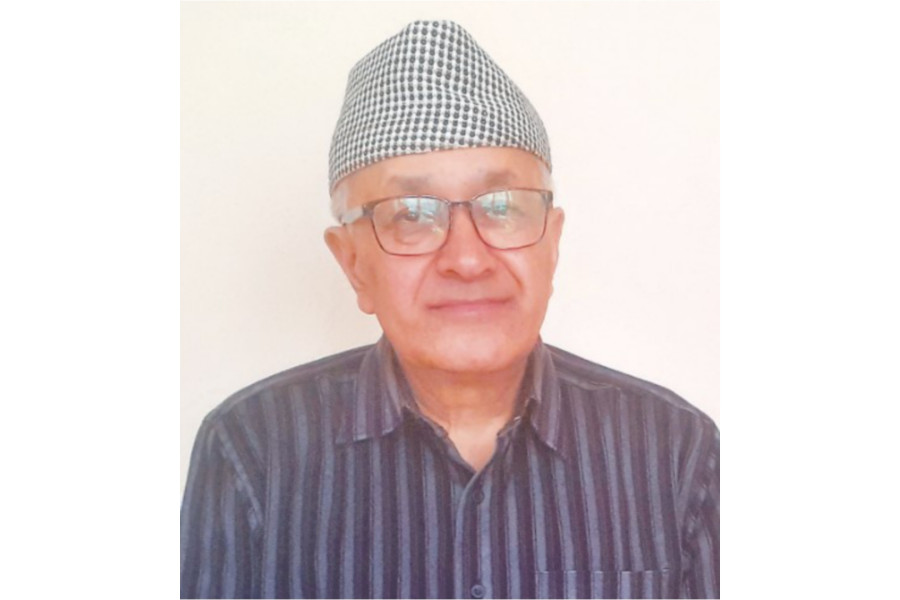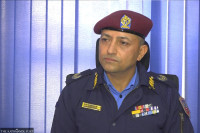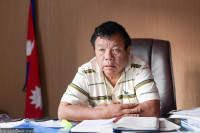Interviews
CIAA should appeal acquittal of politicians in Supreme Court
We concluded that no court can say that the Lalita Niwas land is not government land. We had strong evidence to prove that.
Thira Lal Bhusal
The Special Court on Thursday issued a verdict on Lalita Niwas land grab case. While the court convicted other accused, it acquitted politicians. What is the Lalita Niwas issue? How was it probed and what are its lessons? The Post’s Thira Lal Bhusal sat down with former government secretary Sharada Prasad Trital, head of the Lalita Niwas land grab probe committee, for insights.
Can you explain the Lalita Niwas land grab case for our readers?
The area was called Lalita Niwas camp. After the Panchayat regime was installed in December 1960, there was a dispute over whether the government had confiscated or acquired the land of Nepali Congress leader Subarna Shamsher by giving compensation. A Cabinet meeting on June 29, 2018 formed our committee and tasked us with finding out whether the Lalita Niwas camp land was confiscated or if there had been proper compensations. When we studied the documents, we found that Subarna Shamsher had bequeathed the land to those who had a share there, just a few months ahead of the political change. He retained 14.1 ropanies of land in joint ownership of himself and his youngest son. The documents indicate that the government confiscated the 14.1 ropani of land. Transaction of the rest of the land was blocked. In the meantime, a new law on land management was introduced in November 1964.
Two weeks after that, a Cabinet meeting decided to acquire seven palaces of Ranas including the Lalita Niwas for government use. Then, a notice on their acquisition was published in Gorkhapatra. The land seems to have been acquired based on that notice. We didn’t get a copy of the Nepal Gazette of that particular decision. It indicated some wrongdoings. We found notices were issued multiple times as people concerned didn’t contact the authorities.
In 2043 BS (1986-87), all the beneficiaries received money for the acquired land. In 2044 BS, (1987-88) the chief zonal office wrote to the land revenue office that all the owners of the Lalita Niwas land have received the compensation amounts, so the area can now be registered in the name of the government. We found that letter. The notice and the letter were the major bases to prove that it was government land. The Special Court’s latest decision is based on the same evidence that we collected at the time.
There was again a political change in 1990 and a democratic government was subsequently formed. Only weeks after the restoration of democracy, the Bagmati Zonal Land Revenue Office was destroyed in a fire on April 23, 1990. The relevant documents were gutted. On May 28, 1990, the Krishna Prasad Bhattarai-led Cabinet decided that if anyone’s land was confiscated based on political bias, such property should be returned on the basis of study and evidence. The civil servants didn’t proceed with the process to return land just based on that decision. Again the government made another decision on 23 July, 1990 that instructed the authorities to determine the confiscated area and compensate the rightful owners. The civil servants still didn’t implement the order.
Then, the government on August 19, 1990, decided that the home ministry would investigate the matter and take action based on its findings. As the government was unable to determine the area under dispute, those who were trying to gain the land tried to capture all of the Lalita Niwas area. Some Ranas who claimed to be owners of the land, civil servants working at the land revenue office and middlemen active in land transactions acted in collusion. Then, after a few years, the land was given to some Ranas without following due process.
Some individuals, who knew how a nexus was converting the public property into private property, then started registering complaints against efforts to transfer the government land in individuals’ names. Lawyer Yubaraj Koirala was one of those. In 2018, when Prem Kumar Rai became the secretary at the home ministry, Koirala briefed him about this case. He showed all the evidence and how the government land was being illegally transferred to individuals’ names. Convinced, the home secretary talked to the erstwhile prime minister KP Sharma Oli, who gave a go ahead to form a committee and probe the matter. Thus the committee under my leadership was formed at the secretary’s initiative.
How did you investigate the complex issue?
Our major task was to first unearth whether the land was confiscated or acquired by giving compensation to the landowners. We also studied whether a Cabinet-approved committee had ever been formed to study the matter. We found out that no such committee had been formed. But the land was transferred in the names of individuals. We started our study from 1960 when the process to acquire the land had begun. We studied government documents, notices, Nepal Gazettes and newspaper archives. Many crucial documents, letters and notices were missing. We found evidence of blocking the land transaction. We were clueless for three months. As we couldn’t get the main documents, we decided to try to find something from the agencies that are notified about the land transaction deal. There was the Urban Development Section in Kathmandu that used to get the carbon copies of the transaction.
At the office, we obtained a carbon copy of a correspondence sent to the land revenue office by the zonal office on Lalita Niwas land acquisition deal. In the letter, the zonal office asked the land revenue office to register the Lalita Niwas land in the name of the government as all landowners had already received compensation. Other vital details were given in the letter. That in turn helped us find many other important notices, decisions and transactions from various libraries and from the department of archeology. We found some documents had been destroyed while many fake documents were created.
So, our major finding was that this needs to be investigated by the Commission for the Investigation of Abuse of Authority because there is corruption and also the Central Investigation Bureau (CIB) of Nepal Police as there is forgery and other criminal acts. Our third suggestion for the government was to form a judicial commission to probe land grab cases across the country. As per our recommendations, both the CIAA and the CIB started investigation in respective cases. Also, the government formed a commission led by Mohan Raman Bhattarai. That commission in its report said it had received 101 complaints and its initial investigation found illegal land grab instances in 33 places. But the government didn’t extend its term as many of those involved in these grabs were politicians, including central level leaders. In this case, two individuals, lawyer Yubaraj Koirala and then home secretary Prem Kumar Rai, played an important role in laying a strong ground for this investigation.
What is the most important finding of the committee you led that made the court convict the accused?
Our conclusion was that no court can say that the Lalita Niwas land is not government land. We had gathered strong evidence to prove that the land belonged to the government. But we weren’t sure whether those involved in the scam would be punished.
But while the court convicted civil servants, as well as those who claimed to be rightful landowners and those involved in land transactions, it acquitted former prime ministers and ministers, who were the decision makers.
There is no room to question the court verdict as far as those found guilty are concerned. The civil servants and middlemen are actively involved in this crime while politicians have protected them. So, all three sides are guilty. As far as the court’s decision to acquit former ministers is concerned, it has two grounds. First, the CIAA Act itself is controversial. A provision of the Act bars action on any policy decision taken by the Council of Ministers or any committee thereof or judicial actions of a court of law. Citing the same provision, the CIAA excluded former prime ministers while filing the court case. The judges, while giving the verdict, acquitted the accused ministers, too, arguing that if the prime ministers and other ministers, who are part of the Cabinet’s collective decision, aren’t guilty, even the ministers who presented the proposals at the meeting wouldn’t be guilty. In fact, if a decision has helped in corruption, all those involved in the process should be held responsible. In my opinion, the Cabinet decisions made in this connection have abetted corruption. But the authorities misused a legal loophole.
What is the loophole?
The provision that bars the CIAA from investigating ‘policy decisions’ made in Cabinet meetings. The law itself does not define which are policy decisions and which are not. The anti-graft body has to categorise them. The CIAA officials know it. But they seem to have come under the influence of leaders and taken decisions in favour of the politicians.
How can a decision to transfer government land to certain individuals be a policy decision?
That never can be defined as a policy decision. In fact, that’s a criminal decision. Certain individuals were made land tenants (mohi) while transferring the ownership. The Cabinet meetings have determined land tenants, fixed plots and transferred the ownership. These tasks fall under the jurisdiction of district land reform offices, survey department and land revenue offices respectively. Therefore, this is abuse of authority committed by the Cabinet meetings. It is clear that these proposals were forwarded to the Cabinet to avoid CIAA investigation. Later, we found collusion between politicians, top bureaucrats at the prime minister’s office, lawyers, middlemen having strong political connections and business persons. Some of them were given plots in return for getting favourable Cabinet decisions. All those involved in such crimes and corruption should be punished.
The former prime ministers in question often say they weren’t informed about wrongdoings in the case.
That is a lame excuse. There is a law secretary in the prime minister’s office. When they have any proposal involving complex legal matters, the law secretary can immediately give accurate information and advice. Had the prime ministers sought their advice, the law secretary would immediately have said that it is a case to be resolved by a district land reform, or survey or land revenue offices and not an issue to be decided by Cabinets. It is that simple. They didn’t seek concerned officials’ suggestions as it was all part of a plan. Therefore, it was clearly an abuse of authority. So, the Cabinet members involved in taking such decisions shouldn’t have given clean chit.
Does this further underscore the need to define what are policy decisions and what aren’t in the CIAA Act?
In a democratic country, no one involved in corruption should get impunity, whatever position the person may hold. In fact, the decision makers should be more responsible. The CIAA should be able to arrest even a sitting prime minister if they are corrupt. There is no need to include such provision in a law. If there is a need, it is to clearly define policy decisions. In fact, only five percent of the decisions made in our Cabinet meetings are policy decisions.
Do you think the CIAA should go to the Supreme Court seeking action against those who weren’t convicted by the Special Court?
I think the CIAA should appeal in the Supreme Court because giving impunity to politicians will pull the country deeper into the muck of corruption. In order to control corruption, those who hold top positions should be made more responsible.
How can this entrenched trend of corruption be broken?
We can’t expect much reform so long as the current set of leaders are at the helm. Top leaders of all major political forces are involved in corruption cases. So, they don’t work sincerely to control it. There should be a revamp in politics.
There is also a growing trend of capturing public land across the country. How do we stop it?
Based on our report’s recommendation, a judicial commission was formed under former judge Mohan Raman Bhattarai. The body submitted a report about land grabs in 33 places. It had initiated investigations in other 101 similar cases but the government at the time didn’t extend its tenure. A similar commission should be formed and given not months but years to investigate as there are thousands of cases of land grab across the country. One notable thing is that in almost all the land grab cases, politicians are involved, and many of them are communist leaders and cadres. Likewise, the majority of ‘land mafias’ are lawyers. If their property is investigated it would expose many other things.
In every major scam, there is a nexus between politicians, bureaucrats and middlemen. How do we break such a nexus?
It is possible only if there is a prime minister who is determined to do so. Initiatives taken by other people can’t make a big difference.




 18.12°C Kathmandu
18.12°C Kathmandu












